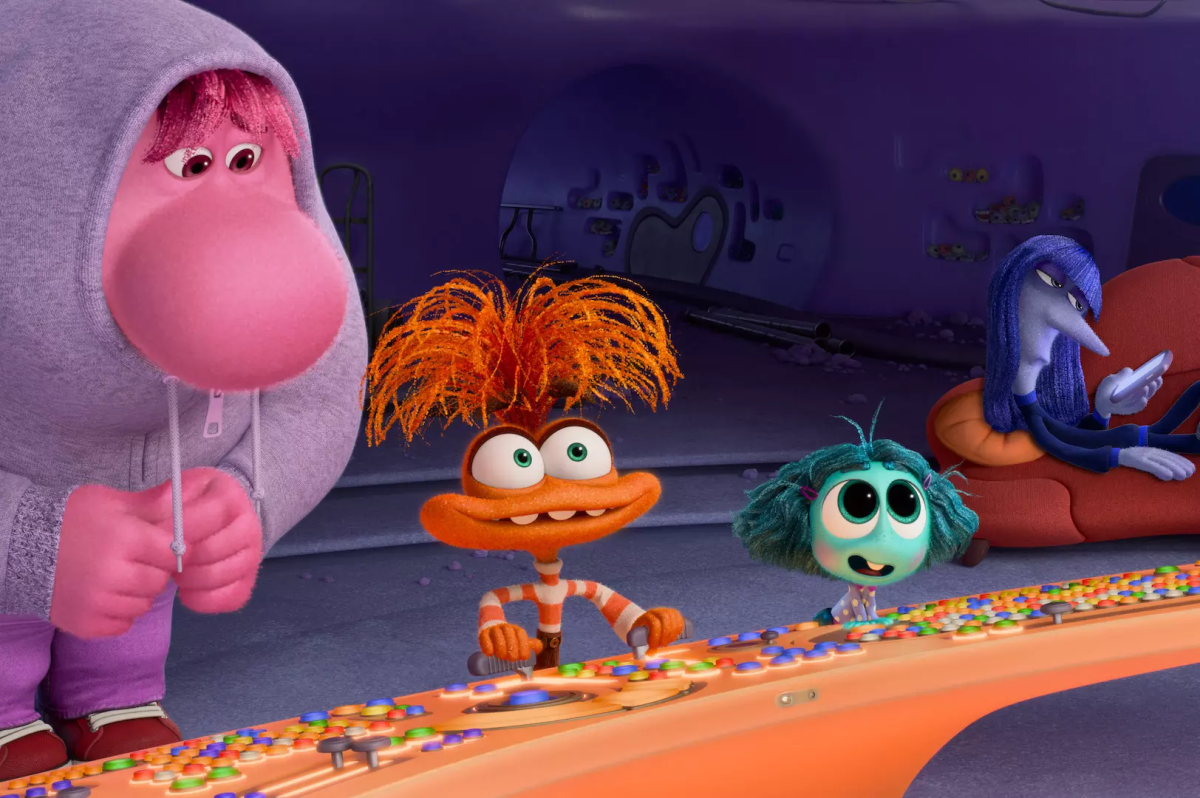Struggling with confidence and the crushing feeling of “I’m not good enough” is an all-too-common adolescent experience, perfectly portrayed and overcome in Pixar’s “Inside Out 2.”
The original “Inside Out,” released in 2015, was one of the most loved animated films of the decade for its beautiful animation and complex story. With an audience rating of 91% from Rotten Tomatoes, it became a contemporary classic, winning several accolades, like the Best Animated Film Award in 2015 by the National Board of Review. Pixar, known for fun movies portraying children’s lives and imaginations, released the sequel June 14, depicting a middle school Riley with new, complicated emotions. “Inside Out 2” features new, relatable emotions showing vulnerability through the character of Anxiety and providing an overall inspiring message about growth.
“Inside Out” depicted characters that controlled the inner mind of 11-year-old protagonist Riley as the personifications of emotions: Joy, Sadness, Anger, Disgust and Fear. In “Inside Out 2,” three new emotions were introduced as Riley begins adolescence: Envy, voiced by Ayo Edebiri; Embarrassment, voiced by Paul Walter Hauser; Ennui, which translates to boredom, voiced by Adèle Exarchopoulos; and Anxiety, voiced by Maya Hawke. Anxiety takes charge of Riley’s mind, suppressing her core emotions and replacing Joy entirely. Riley experiences the effects of Anxiety: overthinking about whether she’s likable, and as a result losing old friends as she starts hanging around the seemingly cooler hockey team at her future high school.
The movie started out with a seamless introduction, transitioning from “Inside Out” to its sequel. Riley, voiced by Kensington Tallman, and her friends find out they aren’t going to the same high school, which rattles her. The captain of the high school’s hockey team, Val Ortiz, voiced by Lilimar Hernandez, invites Riley to hang out with her, leading Riley to abandon her original group of friends during summer hockey camp. Anxiety takes over Riley as she does anything to get closer to Val, which causes her to grow more competitive and distant.
Riley’s sense of self changes for the worse as Anxiety’s control persists, going from “I am a good person” to “I am not good enough.” Anxiety’s plan to improve Riley’s image officially backfires when Riley gets a panic attack during one of the final games that determines if Riley will make the hockey team. Anxiety freezes when Riley has a panic attack, allowing Joy to resume control once more. Joy creates a new sense of self embracing all the parts of Riley — her most embarrassing memories, her happy memories, her sad memories, her anxious memories, etc. As Riley’s new sense of self arises, she overcomes her panic attack, makes amends with her friends and begins to understand her new self. Riley’s emotions come to understand that all her feelings are valid and make her a complete person. “Inside Out 2” succeeds at being relatable and comforting through its honest depiction of the discomfort of adolescence — where emotions become more convoluted as people get older.
This notion is best seen in Riley’s overthinking process, especially when she strives to join the high school hockey team at all costs. Anxiety’s characterization in this film greatly embodies the inner turmoil and personifies the change that happens to Riley during such a critical life stage, especially in the versatility of Anxiety’s actions, such as Riley getting anxious over little things like how she is acting or talking, as well as the extent of the pressure people put on themselves to achieve their goals. Viewers can easily relate to their own experiences of anxiousness, which is the driving force of the film’s comforting and validating tone.
Pixar continues to accurately portray what it is like to grow up with this second installment of the “Inside Out” series, especially the heightened emotions of adolescence. According to SFGATE, the producers were helped by nine teens from all over the country who helped make sure that the movie didn’t have moments that could’ve been deemed as “too cringe.” In a scene of the film Riley and her friends were scolded by the coach, which embarrasses her. The secondhand embarrassment seeps out of this scene and into the audience itself by emphasizing the familiarity of an embarrassing moment without breaking viewers’ immersion.
“Inside Out 2” beautifully touches on new emotional experiences, such as suppressing your emotions and insecurity. The movie highlights the complexity of growing up, and what it means to have a sense of self as you grow older.






